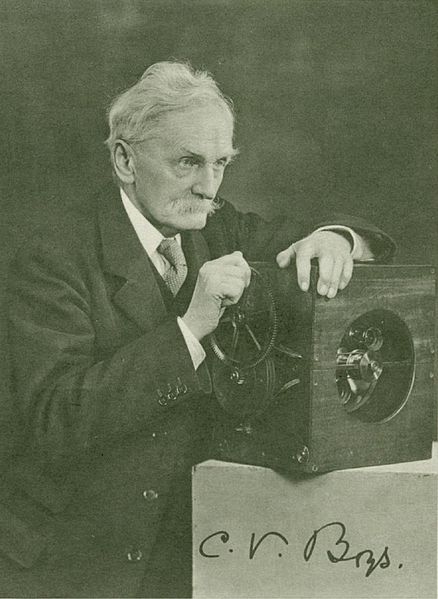Sir Charles Vernon Boys, FRS[2] (15 March 1855 – 30 March 1944) was a British physicist, known for his careful and innovative experimental work.[3]
Early life
Boys was the eighth child of the Reverend Charles Boys, the Anglican vicar of Wing, Rutland. He was educated at Marlborough College and the Royal School of Mines, where he learned physics from Frederick Guthrie and taught himself higher mathematics while completing a degree in mining and metallurgy. As a student at the School of Mines he invented a mechanical device (which he called the "integraph") for plotting the integral of a function. He worked briefly in the coal industry before accepting Guthrie's offer of a position as "demonstrator."

Charles Vernon Boys
Experimental physics
Boys achieved recognition as a scientist for his invention of the fused quartz fibre torsion balance, which allowed him to measure extremely small forces. He made the fused quartz fibres for his instrument by attaching a quartz rod to a crossbow quarrel, heating to rod to the point of melting, and firing the crossbow. By this means he produced fibre so thin that it could not be resolved with an optical microscope.[2] He used this invention to build a radiomicrometer capable of responding to the light of a single candle more than one mile away, and used that device for astronomical observations. In 1895 he published a measurement of the gravitational constant G that improved upon the accuracy achieved by Cavendish. Boys's method relied on the same theory as Cavendish's, but used two masses suspended at one height and two nearby masses suspended at a different height, to minimize the unwanted interaction between opposite masses.[4]
Public service and educational work
In 1897 Boys became a Metropolitan Gas Referee, charged with assessing a fair price for coal gas. He initially worked on the replacement of the standard candle, used to determine the quality of the gas for lighting, by the Harcourt pentane lamp. As heating grew to become the principal use of coal gas, Boys undertook fundamental work on calorimetry to measure and record the heat content of the gas, achieving a substantial increase in precision of measurement. At this time the national gas bill for the United Kingdom was fifty million pounds, so a one-percent correction to the bill represented a very significant amount of money.[2]
Boys also worked on high-speed photography of lightning and bullets in flight, and conducted public lectures on the properties of soap films, which were gathered into the book Soap Bubbles: Their Colours and the Forces Which Mould Them, a classic of scientific popularization. The first edition of Soap Bubbles appeared in 1890 and the second in 1911; it has remained in print to this day. The book deeply impressed French writer Alfred Jarry, who in 1898 wrote the absurdist novel Exploits and Opinions of Dr. Faustroll, Pataphysician, in which the title character, who was born at the age of 63 and sails in a sieve, is described as a friend of C.V. Boys (see also 'Pataphysics).
Recognition
Boys was an assistant professor at the Royal College of Science (now Imperial College London) in South Kensington from 1889 to 1897, as well as an examiner at the University of London. In 1899 he presented the Royal Institution Christmas Lectures. He was elected to the Royal Society in 1888[2] and knighted in 1935. He was awarded the Royal Medal in 1896 and the Rumford Medal in 1924. He was awarded the Elliott Cresson Medal in 1939.
Personal life
He married Marion Amelia Pollock in 1892. She caused a scandal by having an affair with the Cambridge mathematician Andrew Forsyth, as a result of which Forsyth was forced to resign his chair. Boys divorced Marion in 1910 and she later married Forsyth.
References
^ a b J J O'Connor and E F Robertson, "Sir Charles Vernon Boys", MacTutor History of Mathematics archive, University of St Andrews
^ a b c d Rayleigh (1944). "Charles Vernon Boys. 1855-1944". Obituary Notices of Fellows of the Royal Society 4 (13): 771. doi:10.1098/rsbm.1944.0021. edit
^ O'Connor, John J.; Robertson, Edmund F., "C. V. Boys", MacTutor History of Mathematics archive, University of St Andrews.
^ "On the Newtonian Constant of Gravitation". Nature 50 (1292): 330. 1894. doi:10.1038/050330a0. edit
Retrieved from "http://en.wikipedia.org/"
All text is available under the terms of the GNU Free Documentation License

